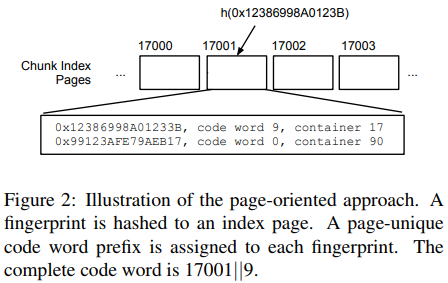File Recipe Compression in Data Deduplication Systems
| Venue | Category |
|---|---|
| FAST'13 | Metadata Compression |
File Recipe Compression in Data Deduplication Systems1. SummaryMotivation of this paperFile Recipe CompressionImplementation and Evaluation2. Strength (Contributions of the paper)3. Weakness (Limitations of the paper)4. Future Works
1. Summary
Motivation of this paper
The corresponding file recipe data can occupy a significant fraction of the total disk space.
if the deduplication ratio is very high
This paper proposes a combination of efficient and scalable compression schemes to shrink the file recipes's size.
Chunk index: disk bottleneck file recipes: contains a list of chunk identifiers.
In a standard file system, the block pointer is stored in at most 64 bits.
file recipes that store cryptographic fingerprints have a size of at least 20 bytes
File Recipe Compression
- File recipies may occupy a significant portion of the overall storage in a backup deduplication systems.
the file recipes grow linearly with the size of the stored logical data.
- One way to reduce the file recipes's size is to use larger chunk sizes.
this decreases the deduplication ratio.
- Key Idea: Assign a small code words to fingerprints.
the code word is then stored instead of the fingerprint in the file recipe.
And this paper wants to investigate different approaches to select the code words.
- Method 1: Zero-Chunk Suppression Observation: a few chunks are responsible for a high number of duplicates
Zero chunk: the chunk completely filled with zeros. zero chunks are common in VM disk images.
It is easy to detect zero chunks and replace them with a special code word by pre-calculating the fingerprint of the chunk filled with zeros.
- Method 2: Chunk Index Page-oriented Approach Aims to assign a code word to all chunks
is not significantly longer than necessary to have a unique code word for each chunk in the system
This approach uses chunk index's pages to assign code words.
code word consists of two parts: prefix and suffix. (page id | unique identifier in page) The combination of suffix and prefix together uniquely identify the fingerprint. prefix: used to identify the index on-disk page where the fingerprint is stored on. suffix: in the on-disk page, it can search the fingerprint entry with the matching suffix.

- Method 3: Statistical Dictionary Compression This method generalizes the zero chunk suppression.
- assign shorter code words to fingerprints based on the probabilies of the chunk usages.
- the usage of fingerprints is highly skewed, certain fingerprints are more likely than others.
- A small set of common fingerprints gets a short code word.
Assign code words to chunks below a entropy threshold:
E.g., around 0.3% of the chunks Need to maintain (in-memory) reverse index`
The statistical model relies on a fingerprint's usage without looking at its context. (e.g., previous fingerprints in the data stream)
use fingerprint entropy to measure the length of code word.
Issue the entropy of each chunk is not known in advance and can only be estimated after some data has been written.
only assign code words after one or more backups. (The first fingerprints have to be stored unmodified) This paper assumes it is effectively possible to estimate the overall probability of a chunk. (garbage collection)
- Method 4: Statistical Prediction Compression For each chunk
- Determine most-likely following fingerprint
Based on order-1 statistic Data structure for order-1 too large at scale
- Select as prediction fingerprints
- Replace correct prediction by 1 byte code
Using estimation of most-frequent following fingerprints
This paper mentions it uses the Misra-Gries Algorithms to approximate the detection of frequent fingerprint pairs.
Implementation and Evaluation
Evaluation: Trace-based simulation of weekly full backup, three datasets
Compression Ratio: Pages-Based and Statistical Prediction Combined compression ratio: four methods
2. Strength (Contributions of the paper)
- This paper proposes some new compression approaches for file recipes. And the combination approaches can shrinks file recipes by more than
3. Weakness (Limitations of the paper)
- The writing of this paper is not very clear, I cannot fully understand the last two methods easily.
- In the statistical dictionary compression, it mentions its method is similar to Huffman coding. However, in order to implement this method to billions of chunks, it needs to relax to non-optimal.
- For non-backup systems, file recipe overheah and compression may not be important.
4. Future Works
- In this paper, it mentions how to estimate the overall probability of a chunk.
It says the number of references to a chunk (usage count) is often collected for garbage collection purpose. This can make usage count be calculated easily.
- The redundant data found by the deduplication process is usually clustered together and forms larger sequences of redundant and unique chunks.
- Some compression approaches in this paper can also be deployed to save the space of metadata in deduplication system.